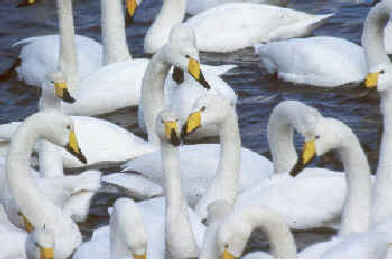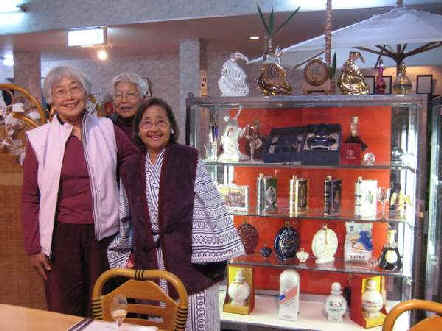
E-mail: font@focusonnature.com
Phone: Toll-free in USA 1-800-721-9986
or 302/529-1876; Fax: 302/529-1085
 |
PO Box 9021,
Wilmington, DE 19809, USA E-mail: font@focusonnature.com Phone: Toll-free in USA 1-800-721-9986 or 302/529-1876; Fax: 302/529-1085 |
THE
FOCUS ON NATURE TOUR IN JAPAN
December
2007
with Cranes,
Eagles, the Blakiston's Fish Owl & More

Whooper Swans
that winter on the northern Japanese island
of Hokkaido
Links:
List of Birds during our Japan Tour - December '07
List of Birds during FONT Japan Tours in 2007
Cumulative List of Birds during our Japan Tours (with photos)
Upcoming FONT Japan Birding & Nature Tours
The following narrative was written by Armas Hill, leader of the tour:
It all began for me at the airport in Philadelphia in the US. I was there,
early, awaiting my flight to Chicago to connect to a non-stop flight to Japan
that could go west over Canada, Alaska, and the Pacific.
At the last moment, the word came that there was a mechanical problem with the
plane and that flight was cancelled. Those who were to connect to go to the
Orient were directed to taxis to JFK Airport in New York, but without enough
time to get there. No one, scheduled for the cancelled flight, would get to
Japan less than a day late. Except me.
Rather than join the ill-fated venture to New York, I convinced the airline
personnel to allow me to take a flight a few hours later in the opposite
direction to Europe - to Frankfurt, Germany - and then continue on another
flight, across mostly Russia, to Japan. Doing so, I arrived to meet our tour
members, in Kyushu, Japan, just under 2 hours later than originally scheduled.
Those people, who became "our group" went to Kyushu from places such
as California, Okinawa, and Thailand.
There have been FONT tour participants in Japan, over the years, from a number
of countries throughout the world including: England, Scotland, the island
of Jersey, France, Germany, the Netherlands, Austria, Hungary, South Africa, and
Australia, in addition to Canada and the United States. Thailand, this time, was
yet another country to be added to that list.
This tour, conducted December 10-18, 2007,
was the 29th FONT birding & nature tour in Japan.
18 of those tours have been in the late-fall and winter. 11 have been in the
spring.
As I was flying east, for hours across Russia, I couldn't help but think of how
vast that land is - huge, actually, Eurasia, continuing further east, over
Siberia. In days gone by, it took a very long time for the early explorers and
scientists to get from places in Europe such as Germany, England, France, and
western Russia, to the frontier of eastern Eurasia and beyond. In the 1700s, for
people such as Steller, Pallas, and Bering, it was a lengthy trip indeed. What I
did in hours, took them months.
I looked out the window of the plane and down upon eastern Siberia and then the
rugged, cliffy coast of the Pacific north of Korea and Manchuria. I was looking
down on a part of the world that's still a wilderness, with Siberian Tigers,
rare Scaly-sided Mergansers, and the mainland Asian populations of Blakiston
Fish-Owls and Red-crowned Cranes. And many other birds, too, occur in
that region that we (our group from places as far away as the US and
Thailand) were to see in Japan.
Such birds, in that category, avian travelers from Siberia to Japan, were to
include: Steller's Sea Eagles (named after the George Steller just
referred to), White-tailed Eagles, Whooper Swans, various ducks,
Rough-legged Hawks, White-naped Cranes, and Hooded Cranes, among the
larger birds, and others, smaller, such as the Daurian Redstart,
Yellow-throated Bunting, Northern Lapwing, and Rook, that only winter
in Japan.
The mainland Asian populations of the Blakiston's Fish Owl and the Red-crowned
Crane, noted a moment ago, never mix with those now isolated on the northern
Japanese island of Hokkaido. During our Dec '07 Japan tour, we saw both of those
species.
The Red-crowned Crane is always great to see - tall and stately. There
are now about 1,000 of them that are residents in Hokkaido - the only place
where the species normally occurs in Japan. Even just 30 years ago, there were
considerably less. That species was determined by votes, at the end of our tour,
to be our favorite bird (the list of "top birds" is below).
The massive Blakiston's Fish Owl in Hokkaido
(also only there in Japan) is not only very big; it's very rare. We saw
it - again. I say "again" as we've seen that spectacular species
during ALL of our 18 late-fall and winter tours in Japan. The rivers in Hokkaido
where the owl occurs were not yet frozen when we were there, this time, in
December. So, we were fortunate to have the good look at the big owl that we
did, one day at dusk.
A number of the birds already mentioned are among the "top
birds" of this tour, as voted by the participants at the end of it. Here's
the list of those "top birds":
#1 - RED-CROWNED CRANE
2 - Steller's Sea Eagle
3 - White-naped Crane
4 - Mandarin Duck
5 - Blakiston's Fish-Owl
6 - Smew
7 - Black-faced (& Eurasian) Spoonbills
8 - Green Pheasant
9 - Harlequin Duck
10 - Mountain Hawk-Eagle
11 - Laysan Albatross
12 - Hooded Crane
13 - wagtails (3 species)
14 - Black Kite
15 - Common Kingfisher
16 - Great Spotted Woodpecker
17 - Daurian Redstart
18 - Meadow Bunting
19 - Rook
20 - Eurasian Wigeon
21 - Pygmy Woodpecker
All of the birds receiving Number #1 votes (except one) were cranes,
with the Red-crowned Crane receiving 3 and the White-naped and Hooded
Cranes receiving one each. The single exception was the Steller's Sea
Eagle that sat so cooperatively, not far from us, atop a pole. Many times,
such eagles don't allow close approach, but the one just referred to was
so reluctant to leave its favored perch, as we stood nearby photographing the
bird, talking among ourselves, and even moving about. We had to conclude that
where that bird came from in Siberia there simply were not many people.
Another raptor that was seen perched in a big tree in Hokkaido was
unexpected. It was the Mountain Hawk-Eagle. The subspecies that's
resident in Japan, Spizaetus nipalensis orientalis, is larger than
others that occur in mainland Asia, in southern China and west into the
Himalayas. The bird that we spotted as we were traveling through hills in
southern Hokkaido was big. It was unexpected because we've never seen it
previously in Hokkaido. It has relatively recently been found to nest there. We
have seen the species during previous FONT Japan tours in the mountains and
hills of Honshu and Kyushu. Southern Hokkaido is the easternmost edge of the
bird's extensive range.
Another raptor that was good for us to see on Hokkaido was the Roughleg.
Now, that name is a compromise. In Eurasia, it's been called the Rough-legged
Buzzard. In North America, it's been known as the Rough-legged Hawk.
With whatever name, we saw a couple of them along the coast, hovering in the
air. One was doing so right above us. It was a nice sight with the backdrop of a
blue sky. Roughlegs in Hokkaido come from either the Kamchatka Peninsula
or further north in Siberia, from the tundra.
Among other birds that come to Japan from Siberia to spend the winter, Whooper
Swans are particularly notable (and hard to miss). On Hokkaido, we
saw them at a number of lakes and inlets. But they are always fun to see, and to
hear. They can be noisy. Hence their name. In that regard, someone during our
tour asked "Why is one a Whooping Crane, and another the "Whooper
Swan?" That's a good question.
Some of the other species of waterfowl during our tour were wonderful birds.
Among them, the Smews that we saw were very nice. The male, with its
distinctive white and black plumage, is truly striking. The red-headed female is
dapper. All in our group were glad to see the Smews as well as we did. One
person was particularly so, as she said that she's seen the word for years in
crossword puzzles. Now, at last, she saw the bird.
Smews come to Japan in the winter from Siberia. They don't nest in Japan.
But Harlequin Ducks do. They occur commonly along the Hokkaido coast. No
matter how common, they're always a treat to see. The male is downright gaudy.
The Falcated Duck is another attractive duck that we saw in Hokkaido. Long-tailed
Ducks, there, along the coastline are also dazzlers.
Scoters, that breed further north in Siberia, were in numbers for us
along the Hokkaido coast. We saw two kinds. The "Black Scoter"
in Japan is actually the American Scoter, now split from the Black
Scoter that occurs further west in Eurasia. The "Steininger's"
White-winged Scoter that we saw is a subspecies of the White-winged
Scoter of North America, rather than the Velvet Scoter of
more-westerly Eurasia.
But maybe no species of waterfowl more exemplifies the Orient than the Mandarin
Duck. It's similar to the Wood Duck of North America, but with a
different coloration. A few years ago, we found during a FONT tour in southern
Kyushu (the southernmost main Japanese island), a river that in the
winter (only) is filled with them. Shy, these wild Mandarins are.
They fly away quickly, calling as they go. These birds, that winter in southern
Kyushu, breed either further north in Japan, or across the sea in mainland Asia,
in places such as Korea and Manchuria. Again for us, in December '07, we saw
hundreds of them. It was quite an experience.
Every winter, thousands of cranes come to southwestern Kyushu from
mainland Asia. Mostly, they are of 2 species: the Hooded Crane and the White-naped
Crane. Not to slight the Hooded, but a comment must be made that the White-naped
Crane is really a most attractive bird.
Both of these cranes are, during the summer, spread out in the land that was
below me when I was in the plane, on my way to Japan from Germany, over eastern
Asia. They nest in Russia and Manchuria (and elsewhere in northern China).
Like me, they fly to Japan. These cranes come to Kyushu, in southern
Japan, by the thousands, arriving mostly in November and departing in February.
In mainland Asia, as noted, they range across a rather large area, but in Japan,
when they visit for the winter, they're restricted to just a few square
kilometers.
We learned, during our December '07 tour, that a couple weeks earlier, the first
count for the season of the cranes in that part of Kyushu was: 10,973
Hooded Cranes, 1,059 White-naped Cranes, 2 Sandhill Cranes, 3 Common Cranes,
and 3 hybrids (between Hooded & Common Cranes).
It's quite a sight to see those cranes at Kyushu. The Hooded Cranes there
are nearly the entire global population of the species. As to the White-naped
Crane, a recent total population estimate was about 5,000 birds. Lately,
about half have been wintering where we were in Kyushu.
We also saw, during our Dec '07 tour, one of the 2 Sandhill Cranes in the
area. The Sandhill Crane is mostly North American, but actually it's also
a breeder in northeastern Siberia. Most of those birds, after nesting, migrate
east to Alaska and then south into North Carolina. But not all. As noted, 2
arrived in Japan in '07 to winter. The species has been an annual there in
recent years.
Another bird that we saw on the southern Japanese island of Kyushu that came
from mainland Asia for the winter was the rare Black-faced Spoonbill. The
global population of that bird of eastern Asia only totals about 700 birds. It
does not breed in Japan. The species nests mostly in Korea, with a few doing so
in coastal China. We saw, in December '07, seven of these birds along with
almost as many Eurasian Spoonbills on a mudflat by the mouth of the river
where, upstream, we saw the hundreds of Mandarin Ducks. The Eurasian
Spoonbill is a winter visitor (a non-breeder) in Japan, occurring in
small numbers.
In an area of Tokyo, near the head of the Tokyo
Bay, we stopped by one afternoon to see the shorebirds. They
were there. Most were Dunlin. Also, in addition to 3 species of
plovers, there were a couple Eurasian Curlews and a small grouping of
Black-winged Stilts. Also stopping by that afternoon to visit the
shorebirds was a Peregrine Falcon that rapidly stooped in causing the
shorebirds to quickly take into the air, flying fast in one direction and then
the other in tight formation. Watching a flock fly like that is always amazing.
A part of our December 2007 Japan tour was offshore, onboard a large ferry from central
Honshu (the main Japanese island) north to Hokkaido.
The ferry-ride was overnight, and then all-day. It's good that the ferry is
large as, at times, the ocean was a bit rough. But during nearly all of the
daytime portion of the trip, there were birds in view. By far, the most were Black-legged
Kittiwakes. We saw thousands of them. It was easy to become very respectful
of that bird as we watched them continually about fly in the strong winds. Of
the two Kittiwakes in the world, the Black-legged is by far the
most common. The other, the Red-legged Kittiwake, is rather rare, and
generally a bird of the more-northerly Bering Sea. "The book" says
that the Red-legged Kittiwake can occur in the offshore waters of Japan.
Maybe so, but we never saw one (that we know of) among maybe 25,000
Black-legged Kittiwakes we saw that day at sea.
What we did see in nice numbers were Laysan Albatosses - at least 75 or
so. It was fun to watch them in their arcing flight. Other seabirds we
saw from the ferry, that December day (Dec 13, 2007) were: some Pomarine
Skuas, both Streaked and Short-tailed Shearwaters, and both Fork-tailed
and Sooty Storm-Petrels. With the storm-petrels, a Pterodroma
quickly appeared - a Bonin Petrel. Then it quickly disappeared.
Gulls (other than the kittiwakes) were in lesser
numbers than during our January trips, and alcids were considerably less,
although some Japanese Murrelets were seen - "umisuzumes",
in Japanese meaning "sea sparrows".
In an area of the ocean where there were many birds above the surface of the
water, and apparently many fish below, there were Northern Fur Seals at
the surface of the water busily catching the fish.
Mammals that were seen on land, during the tour, included: Sika Deer,
Japanese Marten, Japanese Hare, and Eurasian Wild Boar in Kyushu,
and Sika Deer and Red Fox in Hokkaido.
Not just were there birds and animals to be seen, enjoyed, and appreciated
during our December 2007 tour in Japan. There was also the beautiful Japanese
countryside, the culture, and cuisine, in addition to the Japanese
accommodations with the "onsens" (Japanese baths), and the
hospitality of our hosts at the various places where we were. And, of course,
there was our group of travelers from far-flung places such as Thailand and
California. Combined, all of these elements made our tour, simply put, a
wonderful experience.
At the end of it all, I boarded a plane in Japan to continue the journey
completely around-the-world by air, that was done in conjunction with this tour,
flying to Dallas, Texas, and then back to Philadelphia and home.

Some of our Dec 2007 Japan Tour
participants
one evening before dinner
In notes following our DECEMBER 2007 birding
& nature tour in JAPAN:
"Thanks for a great
trip. I hope to see you on one of your tours soon."
Dorothy Kakimoto
Alameda, California
"Thank you for a wonderful trip."
Alice Kakimoto
Garden Grove, California
"Dear Armas,
You are so much fun to travel with --- .
You are a good driver (on the left-side of the road in Japan), and a great
bird-spotter.
Thank you for a safe, amazing trip in Kyushu & Hokkaido on roads less
traveled.
I loved every moment.
What a great trip. Thank you."
Mitsu Wasano
San Jose, California
"Thank you so much for the tour - for the adventure, and the birds".
Somporn Pmasuk & Opapunn Sriyakorn,
Bangkok, Thailand
"In my list (at the end of the tour) of "top-birds", I chose
those I did because I can now identify them by myself. Thanks for
everything!"
Somporn Pmasuk
Bangkok, Thailand